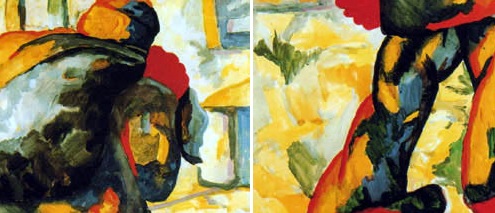Hans Poulis (TU Delft Adhesion Institute) recently received funding from the NWO for his research proposal in the field of adhesive aging. The proposals were accepted in the first round of funding of the Netherlands Institute for Conservation, Art and Science (NICAS). Poulis: “This is the first time that the Adhesion Institute will be developing a new type of adhesive from scratch.”

There are currently all sorts of standard adhesive types in use for the restoration of works of art. Synthetic adhesives are often more stable than natural adhesives, but are not always entirely suitable. They were not developed for restoration purposes and therefore never have all the necessary characteristics. So we usually don’t know how they will alter over time, either chemically or mechanically. In other words, how the substances age over time under environmental influences. They might turn yellow, for instance, or the qualities of the adhesive bond may alter.
Hole in the market
It is a niche market, and not really commercially viable for businesses. Recanvassing paintings requires relatively large amounts of adhesive, but you can imagine that for repasting tiny paint flakes only tiny amounts of adhesive are needed. The Adhesion Institute will be looking into that latter process, and particularly into reverse glass paintings and compositions in oil paint and gouache. These works are typical for many works of art that will need restoring in the short term if we want to preserve them for future generations. Developing a specific adhesive for this purpose is not cost-effective for a company, if only for the high costs of the research involved.
Poulis: ‘Firstly we’ll take two post-doc researchers into the field. I hope to organise a brainstorm session in March with professionals who have years of experience, including curators. They know exactly which requirements the adhesive must meet. Based on the outcome of that session, we will determine the start phase of our research. That will centre on the question: what chemical substance will we base it on? That will be our main ingredient. We will then create different mixtures and depending on the requirements, adapt the recipe accordingly. Using various lab tests we will determine how the mixtures react, initially and over time.’
From test to product
By carrying out aging tests, we aim to find out how mixtures react after a certain number of years. For instance, light exposure tests will enable us to see to what extent such a substance turns yellow over time. For these tests, Xenon lamps are used. They generate UV light and initiate an accelerated aging process. Poulis: ‘Ultimately, we will also test the adhesives on works of art (mock-ups). Of course, in practice you never know precisely what will happen to the adhesive, because of the numerous circumstances that could influence it. Moreover, there are no data available which can link accelerated aging tests to actual conditions.’
The Adhesion Institute has set itself a two-year time limit in which to develop an adhesive which is suitable and stable in the long term when it comes to mechanical and visual performance. The consortium for this research project includes a commercial company specialised in the manufacture of small quantities of adhesive. They would be able to put it into production. Poulis: ‘And who knows, it might generate a spin off.’
---
The NICAS is an interdisciplinary research centre aimed at the conservation of cultural heritage. It works in collaboration with the Netherlands Organisation for Scientific Research (NWO), the Rijksmuseum, the University of Amsterdam (UvA), the Cultural Heritage Agency of the Netherlands (RCE), and Delft University of Technology (TU Delft).
Click here to visit the NICAS website.